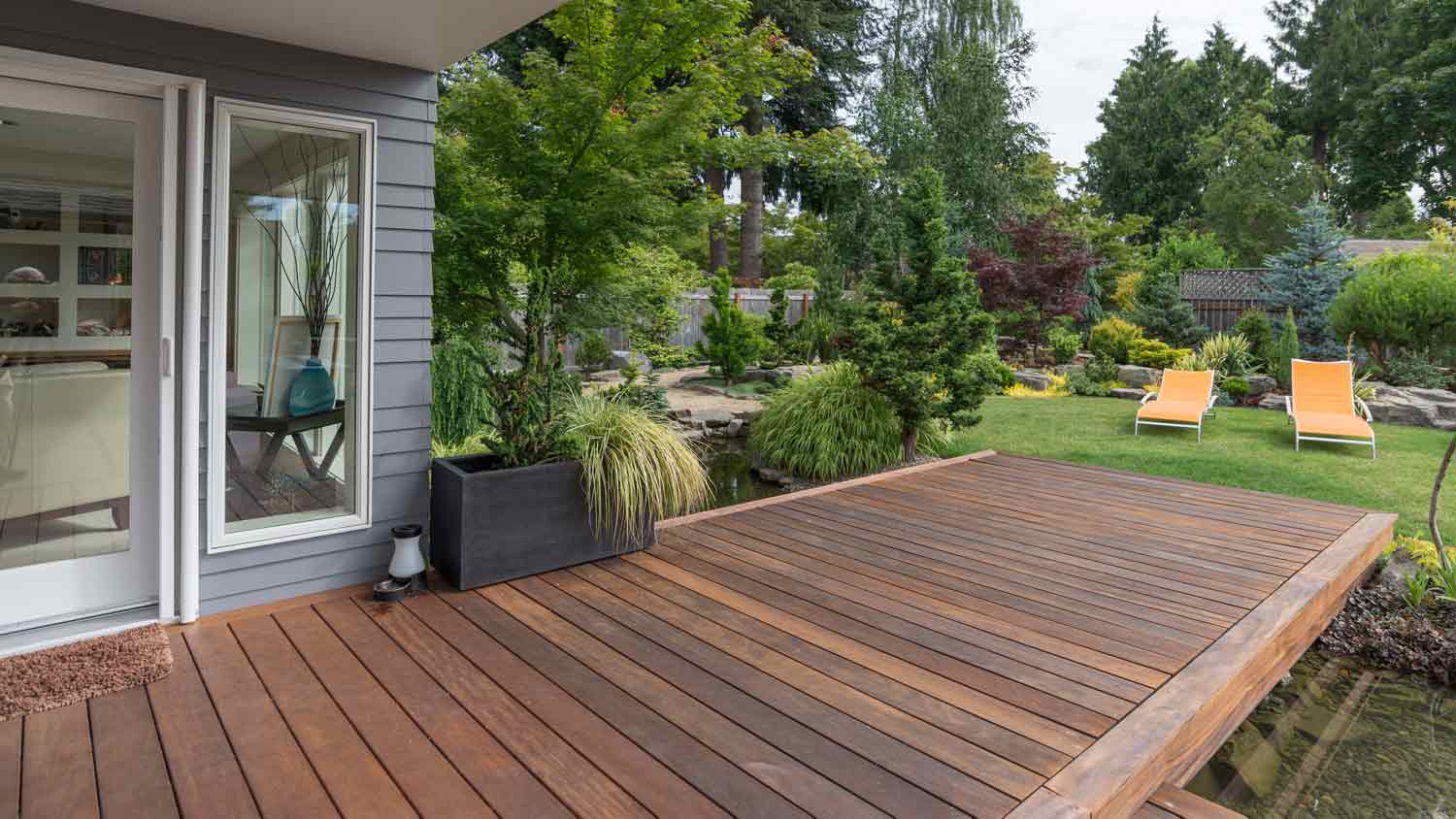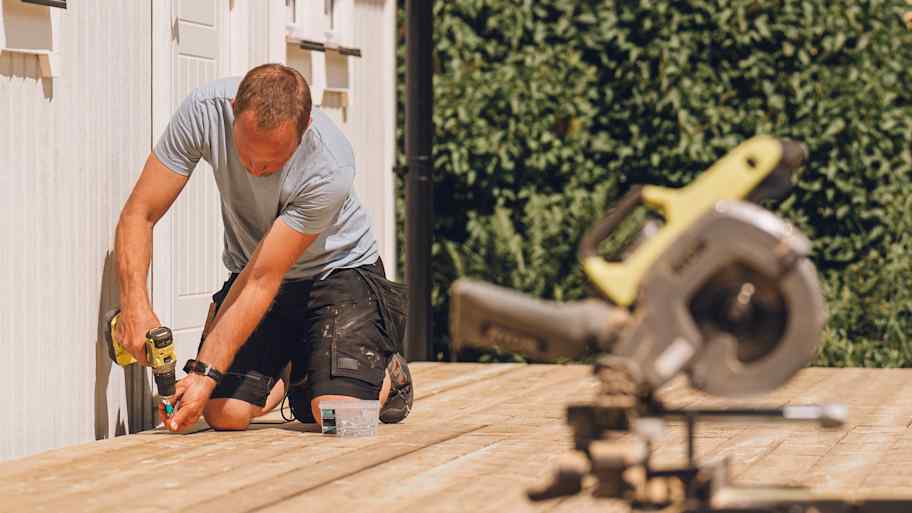Deck replacement costs depend on materials, any structural damage you need to fix, and more. This guide explores how much it costs to replace or repair a deck.
How to Build Deck Stairs: Your Step-by-Step Guide
Step up your deck by constructing DIY stairs


So, you finally have that dream deck—but you also have a wide-open outdoor space that you don’t want to neglect. While parkour is always an option (albeit not the safest or most convenient), learning how to build deck stairs is the best solution to take you down to your yard without a fuss. We’ll walk you through this intermediate-level DIY project below.
Prepping to Install Steps on a Deck

As you may have learned from building your own deck and other home improvements, there are usually local building codes to follow. These will dictate specifics such as stair width and riser height (such as the height from the top of the tread to the top of the one below it). You can find the building codes for most local governments online.
If you choose to install Trex decking or another wood alternative, the building guidelines may differ for stringer placement, riser height, or other recommended reinforcements. Review all the guidelines before purchasing materials and planning your course of action. If you skip this prep work, you may incur fines or have to rebuild the deck stairs before selling your home.
How to Calculate Your Stairs: Your Stair Formula
Before beginning the project, you’ll need to calculate the total number of risers and planks (also known as treads). To do this, start by calculating the total rise of the staircase.
Determine the location of your stair landing. You should shoot for an angle of around 40 degrees from the top of the deck to the landing.
Lay a long level or a wooden board on the top of the deck, extending it until it sits right above your landing point.
Measure the vertical distance from the board (or level) down to the ground. This number will be the total rise measurement you’ll use to determine the number of risers and treads in your staircase.
Number of Risers
To determine the number of risers you’ll need, divide the total rise of your staircase by your desired step height (around 7 to 7¾ inches is standard). Then, round to the nearest whole number.
Helpful tip: If you have stairs in your home you can climb comfortably, measure the height of those risers and use that number for your deck steps. Always double-check building code regulations to ensure your riser height is up to code.
Number of Planks
To find out your total number of planks (or treads), take your total number of risers and subtract one. Any staircase build will always have one less plank than the total number of risers.
How to Build a Stair Landing
If you’re wondering how to build deck stairs, it’s always a good idea to plan for a landing pad. Most building codes require a landing with deck stairs, and many have specific lists of acceptable building materials to use, so check beforehand.
The most popular option is building your own concrete pad (you can also lay your own pavers). Here’s a basic how-to for a concrete landing:
Cut your stair stringers and clamp them into place to test the distance from the deck.
Measure the desired width of the landing pad—around 36-by-36 inches is standard.
If you’re pouring concrete, cut and nail together your wooden concrete form using wooden boards.
Dig a trench deep enough to accommodate your wooden concrete forms or pavers. Keep in mind that your landing pad should be as level as possible, with no more than a ¼-inch slope per foot.
Lay your form into the trench, referencing your clamped stair stringers to ensure it’s even with both sides of the staircase.
Fill the form with a layer of gravel.
Lay rebar or chicken wire on top of the for a second layer of support.
Mix and pour concrete into your form
Screed the concrete by moving a 2-by-4 board back and forth throughout the length of the form, making three to four passes until the concrete sits flush with the form.
Allow the concrete to harden slightly before adding your finish (ex: dragging a broom across to create a textured finish).
Allow the concrete to cure based on the manufacturer’s instructions (usually for 3 to 10 days).
Once the concrete is fully cured, carefully remove the wooden form.
How to Make Stair Stringers and Build Deck Steps

Follow these step-by-step instructions for building stair stringers.
1. Mark the Location of Your Stair Stringers
Start by determining where you'll attach your new steps on the deck, and mark the location where you'll install your stair risers (also known as stair stringers). Make sure you leave at least 36 inches between stringers to allow for enough stair width. Again, be mindful of local building codes and adjust the width accordingly.
2. Measure the Vertical Drop
Measure the distance from the ground to the top of your deck, which is also known as the vertical drop. Take a mental note of this number or write it down, as you’ll need it for calculations in the next steps.
3. Determine the Number of Steps You Need
Take your vertical drop and divide this number by seven to determine the number of steps you need. If it's not an even number (and it probably won't be), round up to the next even number.
4. Calculate Stair Rise Height
Divide the vertical drop by the number of steps you're going to use to get the rise of each stair. For example, if you have a 42-inch drop, you'll need six stairs, each of which will have a rise of 7 inches.
5. Determine the Total Run of the Stairs
Determine how deep you want each stair tread to be, which is the part you will step on. Multiply that figure by the number of steps to get the total run of your stairs.
6. Consider Building a Concrete Pad
You also need to decide if you want a concrete pad at the bottom of your steps or if you prefer to have them sit on the grass. Pouring a pad is possible on your own, but it's time-consuming and requires a lot of tools that you probably don’t already have. Setting the stairs on your grass means more wear and tear for the lawn.
7. Plan Your Deck Stair Stringers
Use your carpenter’s square and pencil to create a stair-shaped pattern on your wood that matches up with the tread depth and riser height of the stairs. You will need at least two stringers to support your deck stairs.
8. Remeasure Your Stringer Markings
You know what they say: Measure twice, cut once. Double-check all your measurements before moving on to the next step.
9. Cut Out Your Stringers
Using a circular saw, begin cutting out your stringer notches per your drawing. Finish your cuts off with a handsaw to avoid cutting too far.
10. Cut Your Deck Boards
Next, cut out deck boards to fit the length and width of each tread as well as each riser. You can use one, two, or three boards per stair, but keep in mind that the more boards you use, the more screws you'll need.
11. Screw Stringers to the Deck Frame
Line up the top of each stringer against the bottom of your deck frame and screw an angle bracket on the side of each stringer, connecting them to the deck. Double-check your markings from step two to ensure the stringers are the right distance apart to fit the length of each tread.
12. Attach Deck Risers
Attach your risers to the stringers using three-inch deck screws. Use at least two screws per riser.
13. Screw in Your Deck Treads
Lay your tread boards perpendicular to your risers on the stringers. Ensure these are level and screw them in by drilling through the tread board into the edge of the stringer where they’ll connect. Again, use at least two screws per tread board.
How Much Does It Cost to Build Deck Stairs?
The average cost to build deck stairs, including materials and labor, is between $30 and $60 per square foot. The number and height of the stairs, the complexity of their design, and the type of material all influence the final costs.
DIY vs. Hiring a Pro
You can save up to 50% on the total costs by building deck stairs yourself. However, this isn’t a project for an amateur DIYer. You need the right tools and design savvy to calculate the correct dimensions, follow building codes, and install a structurally sound set of stairs.
Hire a local deck builder unless you're confident in your abilities. If you get the measurements wrong or struggle with the construction, you could end up with wonky, unsafe steps that don't meet legal code requirements.
The homeowners guide to deck and porch services
From average costs to expert advice, get all the answers you need to get your job done.

Vinyl is a durable and relatively inexpensive choice of decking material. Your vinyl deck cost will depend on labor, the deck size, and more.
Deck repair costs depend on materials, damage you need to fix, and more. See how much it costs to replace or repair a deck in Columbus, OH.

Does your deck make loud popping noises? This is a common and usually natural occurrence. Learn why popping happens in a deck and how to fix it when needed.

You can DIY a floating deck with the right layout, materials, and installation method. Here’s everything you need to know about how to build a floating deck.

You’re designing your dream backyard deck when an important question crosses your mind: “How much decking do I need?”. Figure it out with this deck calculator.

